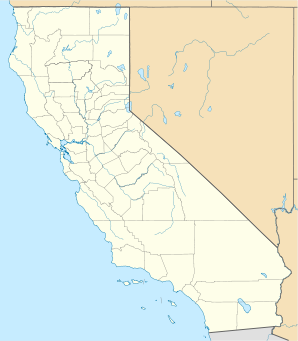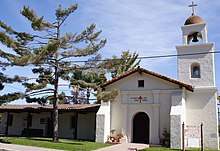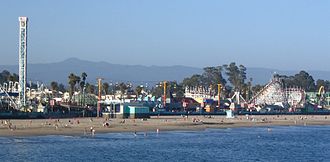Santa Cruz (California)
| Santa Cruz | ||
|---|---|---|
| Nickname : Surf City | ||
 Downtown Santa Cruz |
||
| Location in California | ||
|
|
||
| Basic data | ||
| Foundation : | September 25, 1791 | |
| State : | United States | |
| State : | California | |
| County : | Santa Cruz County | |
| Coordinates : | 36 ° 58 ′ N , 122 ° 2 ′ W | |
| Time zone : | Pacific ( UTC − 8 / −7 ) | |
|
Inhabitants : - Metropolitan Area : |
64,465 (as of 2016) 274,673 (as of 2016) |
|
| Population density : | 1,983.5 inhabitants per km 2 | |
| Area : | 40.4 km 2 (approx. 16 mi 2 ) of which 32.5 km 2 (approx. 13 mi 2 ) are land |
|
| Height : | 11 m | |
| Postcodes : | 95060-95067 | |
| Area code : | +1 831 | |
| FIPS : | 06-69112 | |
| GNIS ID : | 1659596 | |
| Website : | www.cityofsantacruz.com | |
| Mayor : | Ryan Coonerty | |
Santa Cruz is a US city in Santa Cruz County in the US state of California , with a population of 64,465 (as of 2016) and the seat of the county administration.
The urban area has a size of 40.4 km². Santa Cruz is about 100 km south of San Francisco on the northern edge of Monterey Bay .
Northwest of the city is the University of California, Santa Cruz campus .
history
Once the area around Santa Cruz, first of Ohlone was settled -Indianern that was by Spaniards in the mid-18th century Mission Santa Cruz built. It was named after the Catholic name day it was founded.
The mission was the 12th of a total of 21 in Upper California . It was founded on August 28, 1791 by Padre Fermín Lasuén. It was originally built near the mouth of the San Lorenzo, but moved to a higher location after a flood in the first winter. Ohlone and later Yokut Indians worked and lived in it and were converted to the Christian faith. In 1818 the mission was evacuated for fear of a pirate attack. Spanish farm workers and released convicts and soldiers who settled nearby and were actually called to protect the mission, plundered the empty mission. Due to further destruction by earthquakes, mission operations came to a complete standstill in the middle of the 19th century. However, the name Santa Cruz was adopted for the surrounding settlements. The Ohlons were driven out by the Spanish settlers, many died from disease or from hard work for the Spanish colonial rulers.
In the 19th century, the population increased with immigrants from Scotland, Italy, China and Portugal. The Spanish settlers were dispossessed and driven out by the white immigrants after California became a US state.
In the Loma Prieta earthquake in 1989, many buildings were damaged, especially in the center of the city, and some of the brick buildings collapsed. Five people died in the earthquake.
economy
university
The University of California, Santa Cruz (UCSC) is the city's most important economic factor and largest employer. The university's economic impact on Santa Cruz and the surrounding area is $ 1.3 billion. The University of Santa Cruz is also known for its astrophysics and marine science programs. The university is also known for its liberality. For example, it has one of the highest lesbian rates of any university in the USA and is also a playground for hippies and alternative people.
Industry and commerce
Traditional industry and manufacturing have mostly emigrated because of the high costs, but the city's culture, which is quite unique for the USA, forms a good breeding ground for businesses with innovative products. Well-known sporting goods brands such as O'Neill (surf equipment) or Osprey (backpacks) began in Santa Cruz. But also small businesses that deal with alternative energy generation are represented above average in Santa Cruz.
technology
Many smaller technology companies have settled here as offshoots of the computer industry in nearby Silicon Valley. A well-known example is the company Fullpower of the Borland founder and multimillionaire Philippe Kahn .
tourism
Santa Cruz, also known as Surf City USA , was first surfed in California in 1885 . To this day, many international surfing competitions are held in Santa Cruz on West Cliff Drive.
The Santa Cruz Beach Boardwalk , the oldest amusement park in California (worth seeing: Giant Dipper from 1924), forms a basis for tourism as an important economic source of the city to this day.
trade
In addition to the retail chains that are common in the USA, Santa Cruz has a large number of shops that sell organic products. The numerous surf and sporting goods shops are also a hallmark of the city.
traffic
The city is connected to the California expressway network via Highway 1 and Highway 17. The nearest international airport is in San José , the nearest regional airport in Watsonville . The railway line leading from Santa Cruz to Gilroy is only used for tourism by traditional trains. The city administration is planning to expand the route for local public transport. There is a turnoff through the redwoods of Henry Cowell Redwoods State Park ( 37 ° 2 ′ 24.59 ″ N , 122 ° 3 ′ 46.64 ″ W ) to Felton.
The port of Santa Cruz is only of touristic importance and is the starting point for sailors from all over the world. The city operates a small network of city bus routes with connections to neighboring cities and to San José. The bus company Greyhound has a bus station. The inner-city road network is also designed to be very pedestrian and bicycle-friendly. The city has an extensive network of bike lanes and paths.
sons and daughters of the town
- Jeff Ballard (* 1963), jazz musician
- Cornelius Bumpus (1946-2004), rock musician
- Beverly Garland (1926-2008), actress
- Robert Bartlett Haas (1916-2010), literary scholar
- Manu Intiraymi (* 1978), actor
- Pascal Le Boeuf (* 1986), jazz musician
- Remy Le Boeuf (* 1986), jazz musician
- Donny McCaslin (* 1966), jazz musician
- Mary Ann McSweeney (born 1962), musician
- Jonna Mendes (* 1979), ski racer
- Marisa Miller (* 1978), model
- Angie Savage (* 1981), porn actress and actress
- Adam Scott (born 1973), actor
- Chris Sharma (* 1981), sport climber
- Ted Templeman (* 1944), music producer
- Oliver Tree (* 1993), multimedia artist and musician
Web links
Individual evidence
- ^ Santa Cruz City Council: Housing & Community Engagement Study Session. Santa Cruz City, July 27, 2017, accessed March 13, 2019 .
- ^ Economic Impact. Retrieved March 13, 2019 .
- ^ Passenger Rail. Retrieved March 6, 2019 .
- ↑ System Map. Retrieved March 13, 2019 .
- ↑ Santa Cruz CA Bus Station | Greyhound. Retrieved March 13, 2019 .
- ↑ Eureka Cartography: Santa Cruz County Bike Map. Santa Cruz County Regional Transportation Commission, accessed March 13, 2019 .


